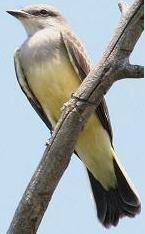Western Kingbird
Identification and Pictures
Western Kingbird (Tyrannus verticalis) The very aggressive Western
kingbirds are 8 to 9 inches. They are light grayish green above.
They have a black tail with white edges, and dark wings.
The throat and upper breast is light gray, below that, and under the wings is light yellow.
Just like the Eastern kingbird they have a bit of red in the crown that is not often seen.
The two sexes look alike.

Young birds look like adults but are
paler; they do not have the red crown, and the wings have a buff edged.
Kingbirds that look similar are the Tropical, Cassin's and Couch's.
Western Kingbirds have a white edge on each side of the tail.
 Eastern
Kingbirds (Tyrannus tyrannus) look
much the same, but are gray-black above and white below, with a white band at the tip of the tail. Eastern
Kingbirds (Tyrannus tyrannus) look
much the same, but are gray-black above and white below, with a white band at the tip of the tail.
Photos by Keith Lee.
The camera I use is the Canon
EOS 40D.
Sound of Western Kingbird
The song sounds like kip-kip-kip, followed by high pitched chitterling. Often
there is just a single kip.
Western Kingbird song:
Click for
Sound 1
Click for
Sound 2
Preferred Habitat
Western kingbirds have a wider range than Eastern
kingbirds because the Eastern kingbirds prefer to be near water.
These birds like open country, and can be seen perching on trees in open areas, fence posts, or utility poles.
They are often found around ranch buildings where there are places to perch.
Breeding and Nesting
The male does a courtship display of twists, and turns in the air to attract the female.
In this display he will fly as high as 60 feet up, and then do
flips
and twits as he falls toward the ground. Western
kingbirds like to nest in pine trees, on a utility pole, building ledges, or even in deserted nests of other birds.
A cup size nest of weeds, grass, and plant
fibers is built by the female. She lines this with plant down, and feathers.
Kingbirds will attack any larger birds that dare to get near the nest. The female will incubate 3 to 4 creamy-white
spotted eggs for about 2 weeks.
The young will be fed by both parents, leaving the nest in 14 to 16 days.
They will be fed by the parents for additional 2 to 3 weeks. about 2 weeks.
The young will be fed by both parents, leaving the nest in 14 to 16 days.
They will be fed by the parents for additional 2 to 3 weeks.
MigrationWestern
kingbirds will migrate in small flocks to southern Mexico, and Central America in late summer.
Food and Feeding
Insects are their main diet, but they also eat small fruits, and berries. Kingbirds can be seen perching on fences or posts, from which they will swoop out to
grab insects. They often hover over fields, and drop down to grab
their prey.
For more on food
and feeding click here.
For more on feeders click here.
To learn about other favorite
birds click here.

|
